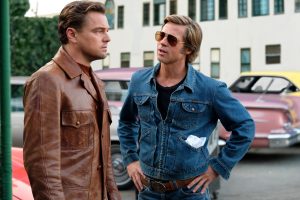It’s 1969, and Rick Dalton is a has-been. A decade earlier, he’d starred in the TV western series, “Bounty Law,” and a few movies, but now the only acting gigs he can get are as the guest-star villain on other people’s shows. At least Rick has his friend, Cliff Booth, who serves as his stunt double, driver, handyman, and wingman through life. Rick lives in the Hollywood Hills, where his neighbors are Roman Polanski and Sharon Tate. He doesn’t know them, but thinks of himself as being “a pool party away” from starring in a Polanski movie.
Rick and Cliff are the central characters in Quentin Tarantino’s latest epic, “Once Upon A Time…In Hollywood,” a tale told in great period detail thanks to a brilliant recreation of Hollywood in that era. I’ve never mentioned the name of a movie’s production designer, but credit must go to Barbara Ling and her crew, who have captured the look of that era to perfection. While I usually detest scenes in which a character like Cliff merely drives down the street for a minute or two with no exposition, I was captivated by them because of the cars, storefronts, restaurants, and movie marquees in the background as Pitt passes them.
While most of “Once Upon” focuses on the exploits of the two male leads, we also get to bask in the glory of Margot Robbie as Sharon Tate at the peak of her career, having just starred in “Valley Of The Dolls” and the last in Dean Martin’s series of secret-agent-spoof Matt Helm movies, “The Wrecking Crew.” In real life, Tate and some friends were brutally murdered by members of Manson’s family, so there’s a sense of foreboding whenever she’s on screen, even when she sits down in a theater to hear the reactions of an audience to her latest screen success. Every time they laugh or applaud, a sly smile crosses her lips, as if she’s thinking, “They love me! If only they knew I’m sitting right here!”
There’s a lot going on in “Once Upon A Time…In Hollywood,” that I won’t tell you, but I will point out a few things to pay attention to:
One is Damian Lewis in a stunning makeup job as Steve McQueen, who we meet briefly at a party at the Playboy mansion. The other is 12-year-old Julia Butters as a young actress Rick encounters while shooting the pilot for another western series, “Lancer.” Her character is scrappy and smart, and their scene together is one of the highlights of “Once Upon.” I predict Butters will be the kid actor who gets to present an award at next year’s Oscars, a la Jacob Tremblay, Abigail Breslin, and Jaden Smith.
Then there’s a huge supporting cast that includes:
- Timothy Olyphant (“Deadwood” and “Justified”) and Luke Perry (in his last role) as the stars of “Lancer,” a real series that lasted two seasons on CBS;
- Mikey Madison (Pamela Adlon’s oldest daughter in “Better Things”), Dakota Fanning (“War Of The Worlds”), and Lena Dunham (“Girls”) as Manson Family members;
- Kurt Russell as the stunt coordinator on “Lancer”;
- Bruce Dern (in full irascibility mode) as the owner of a now-defunct film location that’s become home to Manson’s acolytes;
- Mike Moh as Bruce Lee (who had just played Kato on “The Green Hornet”); plus
- Michael Madsen, Margaret Qualley, Rumer Willis, Clu Gulager, Brenda Vaccaro, and Emile Hirsch.
The only misstep in casting is Al Pacino, in a bad toupee as a Hollywood agent who wants to get Rick into spaghetti westerns. The character is brash and Hollywood-honest, but Pacino’s typical over-the-top read seems wrong to me. Meanwhile, Tim Roth — who, like many others in “Once Upon” has been part of the Tarantino repertory across several movies — only shows up in the end credits with the notation “Cut.” I’ve never seen a director do that for an actor whose scenes had been edited out.
There’s another unseen character in “Once Upon” — Boss Radio 93 KHJ, which was the most popular radio station in 1969 Los Angeles. It’s blasting out of every car in the movie, a recurring presence analogous to Wolfman Jack on the soundtrack of “American Graffiti.” Tarantino even uses actual audio of the station’s morning and afternoon drive stars, Robert W. Morgan and The Real Don Steele, in between the hits and classic Johnny Mann jingles.
DiCaprio is very good as Rick and has the easygoing chemistry with Pitt’s Cliff that you’d expect out of two of their generation’s best actors. But it’s the latter, in his best performance since “Moneyball,” who shines above everyone else in “Once Upon.” Oh, and there’s that one scene where he takes his shirt off that made three women in the theater near me gasp audibly.
Speaking of women, my wife didn’t go to the screening with me, but when I came home and told her she might want to see “Once Upon” despite some trademark Tarantino violence, she asked, “Is it like Bruce Willis in the basement in ‘Pulp Fiction’? Because I couldn’t take that again.” I assured her it was not. In fact, it’s almost cartoonish, and only in one of the last scenes.
It’s clear Tarantino, a cinephile and fanboy, has a passion for that period and the people who populated it. He has assembled a retro-world with meticulous detail, mixing fictional characters with actual events and locations, full of allusions to both his own prior works and others, even as he bends history to a different denouement.
“Once Upon A Time…In Hollywood” will end up near the top of my Best Movies Of 2019 list. The run time of two hours and forty minutes didn’t bother me, but if you have a small bladder, you might skip the 32-ounce soda with your popcorn this time — especially since you’ll wanna stick around for a mid-credits bonus scene.
I give it a 9 out of 10.

